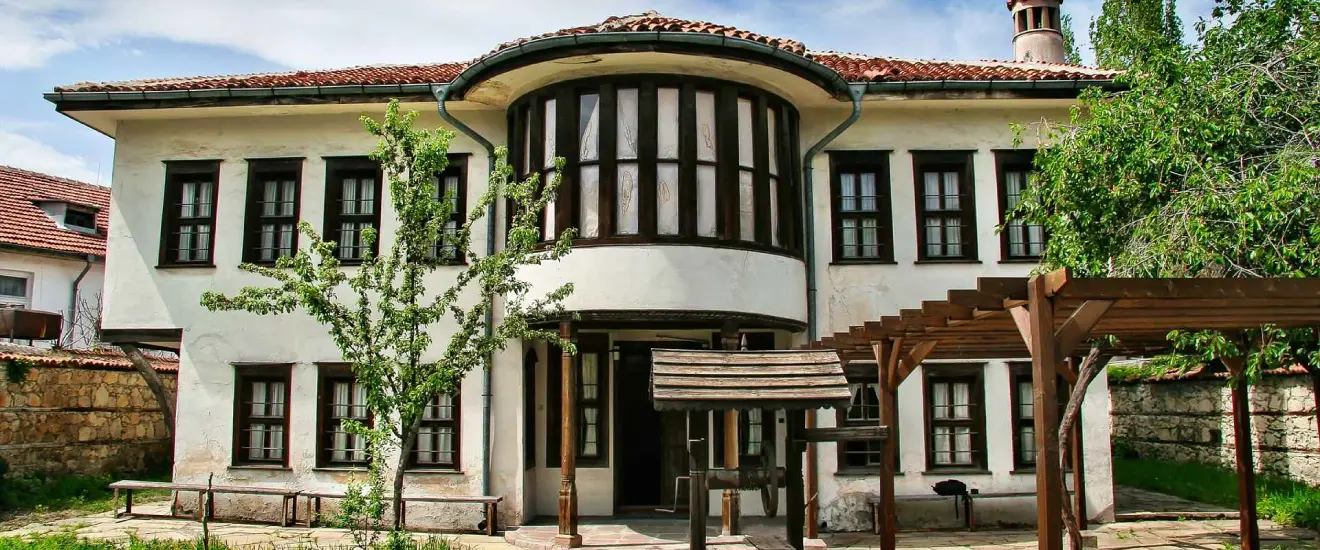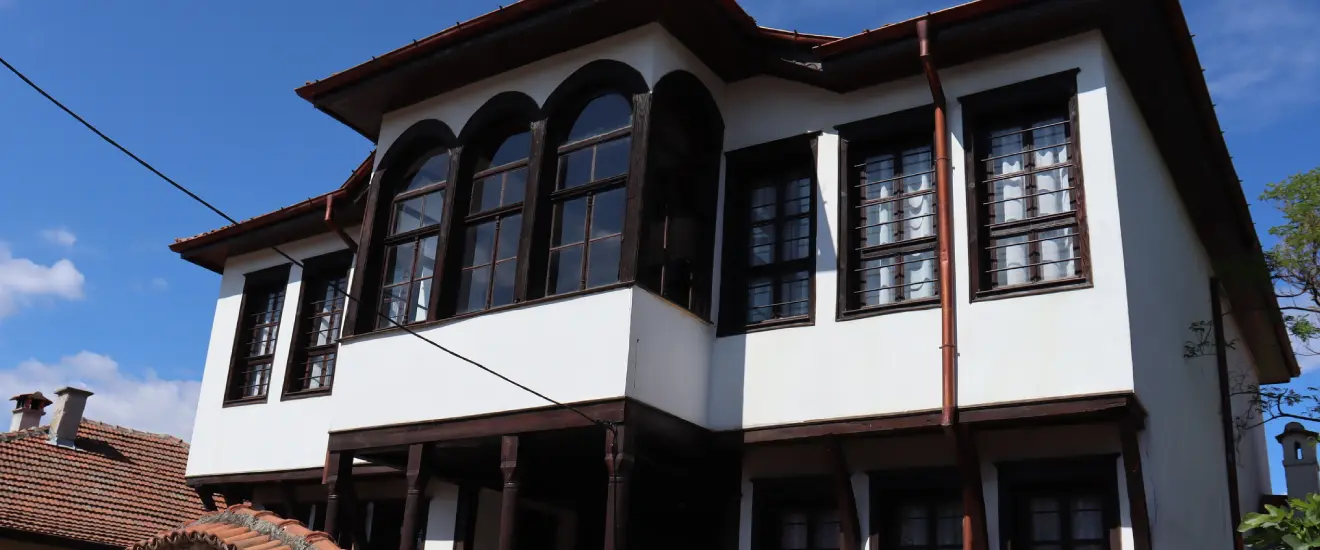Neighbourhood
Filter
- All
- Cultural
- Historical
- Food
- Night life
- Shopping

Monument of Virgin Mary
Only a kilometer and a half from the hotel is the world's tallest statue of the Holy Virgin and Child - a symbol of the city of Haskovo.
The monument was opened in 2003, and two years later, with its impressive 32.8 m height, it was listed in the Guinness Book of World Records, Religion section.
In 2009, it entered the list of the Hundred National Tourist Sites of Bulgaria under number 72.
The monument was opened in 2003, and two years later, with its impressive 32.8 m height, it was listed in the Guinness Book of World Records, Religion section.
In 2009, it entered the list of the Hundred National Tourist Sites of Bulgaria under number 72.

Museum Center “Thracian Art in the Eastern Rhodopes”
In 2009, near the village of Alexandrovo, only 20 km from Haskovo, the Museum of Thracian Art in the Eastern Rhodopes was opened. The most interesting exhibit there is a life-size replica of the Alexander Tomb. A Thracian dome tomb built in the second half of the IV century BC, in all probability belonged to a rich Thracian ruler, whose name remains unknown. The tomb is among the most significant discoveries of Bulgarian archaeology, but it is not open to visitors. It is her replica that gives visitors the opportunity to examine in detail the richly painted frescoes, recreating the feasts of the Thracian aristocracy, battle and hunting scenes.
In addition to a copy of the Alexander Tomb, the museum has a rich exposition with numerous artifacts from the Thracian period in the Haskovo region, a large part of which can be seen in the frescoes of the Alexander Tomb - weapons, ornaments and vessels. Among the most striking exhibits are undoubtedly the 98 gold appliqués found in the northern part of Sakar Mountain, dated 4500-4000 BC, which makes them one of the oldest processed gold in the world.
The Museum Center "Thracian Art in the Eastern Rhodopes" is part of the Hundred National Tourist Sites of Bulgaria.
In addition to a copy of the Alexander Tomb, the museum has a rich exposition with numerous artifacts from the Thracian period in the Haskovo region, a large part of which can be seen in the frescoes of the Alexander Tomb - weapons, ornaments and vessels. Among the most striking exhibits are undoubtedly the 98 gold appliqués found in the northern part of Sakar Mountain, dated 4500-4000 BC, which makes them one of the oldest processed gold in the world.
The Museum Center "Thracian Art in the Eastern Rhodopes" is part of the Hundred National Tourist Sites of Bulgaria.

The Bell tower
With its nearly 30-meter height, the Belfry is an attraction for both Haskovians and guests of the city. Built in 2010, it is located next to the Holy Virgin Monument. It is divided into three levels, each of which offers a view of Haskovo, and eight bells of different sizes and a total weight of more than 1 ton are placed on top of it. Every day at exactly 12:00 noon and 18:00 in the afternoon, you can hear their bell ringing out over a large part of the city.

Uzundzhovo church
The village of Uzundjovo is known for the largest and most famous fair held on the territory of the entire Ottoman Empire. It lasted nearly two centuries, lasting up to 40 days, drawing between 50,000 and 150,000 people. Nowadays, only the "mosque-church" is left of it, unique in its architecture and history. It was built at the end of the 16th century on the idea and with a donation from the Grand Vizier Sinan Pasha. Part of a huge complex for its time, including a caravanserai with accommodation for over 2,000 people, with over 350 rooms and stables for over 1,000 horses. The caravanserai had several entrances with iron doors leading into a courtyard with 80 hearths, 2 hammams, an imaret, many fountains and a fountain.
In 2007, the temple was completely restored. In the courtyard of the church, there is a permanent outdoor information exhibition that tells the story of the Uzundzhovo fair.
In 2007, the temple was completely restored. In the courtyard of the church, there is a permanent outdoor information exhibition that tells the story of the Uzundzhovo fair.

Regional History Museum
The Regional History Museum stores over 120,000 movable monuments of cultural and historical heritage. Unique collections of prehistoric, ancient and medieval ceramics, stone, iron and glass materials, including a collection of over 22,000 ancient and medieval coins, a silver chalice with a donation inscription from the wedding of Emperor Justinian I and Empress Theodora. Here you can see one of the first iron swords found in Europe, an original model of a Neolithic house and artefacts related to the region, from the Neolithic (7000 BC) to the late Middle Ages.
The ethnographic collection displays agricultural and craft tools, copper vessels, ornaments and clothing, works of applied folk art and urban life. The museum also houses collections of weapons, icons and objects related to the educational, ecclesiastical and national liberation struggles of the Bulgarians from the region of the city of Haskovo.
The ethnographic collection displays agricultural and craft tools, copper vessels, ornaments and clothing, works of applied folk art and urban life. The museum also houses collections of weapons, icons and objects related to the educational, ecclesiastical and national liberation struggles of the Bulgarians from the region of the city of Haskovo.

The old clock tower of Haskovo
The old clock tower of Haskovo was built at the beginning of the 19th century, but was destroyed in 1913. In 2013, the tower was rebuilt and quickly took its place among the symbols of the city. It is 23 meters high and is built of cut Uzundzhov stone. Topped by three dials, the tower bell is from the Whitechapel foundry, which produced Big Ben, the Philadelphia Liberty Bell, the London Olympics bells and the Queen Elizabeth II Jubilee bells.

The Kirkov's School
The Kirkov's School was built in 1882 by the Haskovo merchant and craftsman Atanas Hristev - Ortakiuvliata. Over the years, the house has changed its owners, as well as its purpose, many times, and in 2006, the "Haskian Wakers" exhibition was organized and opened here, which was enriched and renovated in 2024.
The house is located in the central part of the city. It is one-story, symmetrical, decorated outside and inside. In it, you can see the modern trends in urban architecture from the end of the 19th century, characteristic of the region.
The house is located in the central part of the city. It is one-story, symmetrical, decorated outside and inside. In it, you can see the modern trends in urban architecture from the end of the 19th century, characteristic of the region.

The Pascal's House
The Pascal's House was built in the second half of the 19th century by the local merchant and benefactor Pascal H. Raichev. The house is two-story, asymmetrical, with beautifully carved ceilings, doors and cupboards, and the decorative niches or so-called "alafrangi" - complement the interior of the house and give it a distinctive sophistication.
Today, Paskaleva House is an ethnographic museum with a permanent exhibition, which has gathered collections of objects of Haskovo wealthy families who lived immediately after the Liberation until the end of the 19th century. The house has been declared a cultural monument of national importance.
Today, Paskaleva House is an ethnographic museum with a permanent exhibition, which has gathered collections of objects of Haskovo wealthy families who lived immediately after the Liberation until the end of the 19th century. The house has been declared a cultural monument of national importance.

Shishman's house
The Shishman house was built in 1854. It is a two-story, symmetrical building, with architecture characteristic of the late Renaissance.
At the end of the 19th century, the house was used as a primary school. Later, a museum exhibition "Home occupations until the end of the 19th century" was arranged in it, which shows the characteristic home occupations in the 19th and the beginning of the 20th centuries in the Haskovo region. Today the house has been restored, and the exposition has been restored and opened to visitors.
At the end of the 19th century, the house was used as a primary school. Later, a museum exhibition "Home occupations until the end of the 19th century" was arranged in it, which shows the characteristic home occupations in the 19th and the beginning of the 20th centuries in the Haskovo region. Today the house has been restored, and the exposition has been restored and opened to visitors.